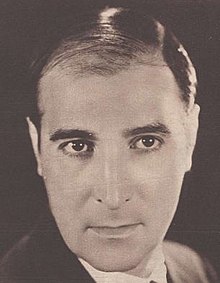Florián Rey
Florián Rey , born in Antonio Martinez del Castillo , (born January 25, 1894 in La Almunia de Doña Godina , Spain ; † April 11, 1962 in Benidorm ) was a Spanish film director , screenwriter and film producer , one of the most famous filmmakers of the Franco era.
Life
Born in the province of Zaragoza, he had studied law for a few semesters in the city of Saragossa before he decided to switch to journalism and in 1915 began to write as an editor for the local daily La crónica de Aradón. After his military service in Spanish Morocco , Rey went to Madrid, where he worked for the capital publications Diario de Avisos and La correspondencia. Rey first came into contact with the film industry through a friend in 1920 and in the same year got a role in the film “ La inaccesible ”. The following year Rey made his stage debut in the play " La maña de la mañica " as a member of the Compañía de Catalina Bárcena ensemble . Florián Rey continued to appear as a film actor until 1923.
Together with his colleague Juan de Orduña , Rey founded the production company Goya Films in 1924 and directed his first feature film with “ La revoltosa ”. His early successes, which emerged during the silent film era, include some works with the Argentine-Spanish singer, dancer and actress Imperio Argentina , who Rey was to marry in 1934. In 1929 he shot the rural love drama “ La aldea maldita ”, his artistically most successful film, which is generally regarded by connoisseurs as the best Spanish silent film. Florián Rey experienced the transition to sound film in 1930 in the Paris studios of Joinville, where he directed Spanish versions of American originals. He also produced a sound version of “La aldea maldita”. He and Imperio Argentina also worked together several times in the 1930s until Rey and his wife left their homeland, which had been shaken by the civil war, and went to Paris in 1936. In 1937, the couple received an offer from Propaganda Minister Joseph Goebbels to film in Berlin. The result was two productions and a personal encounter with Reich Chancellor Adolf Hitler . When Argentina initially wanted to stay in Germany, while Rey intended to return to his Spanish homeland, the couple broke up, which later led to a divorce.
While Florián Rey's early works are closely linked to the Spanish tradition of the local music theater, the Zarzuela , his later films are considered to be largely representative of cinema work during the Franco dictatorship. The avowed supporter of the Franquist and since 1935 partisan Francisco Franco shot an abundance of audience-effective dramas and melodramas, but also comedies and pussies - all films with no artistically remarkable content. Rey ended his activity in 1956 with the unsuccessful comedy “ Polvorilla ”. The following year the director settled in Benidorm and ran a rest stop there until his death. By this time loyalty to the regime had long been forgotten, even under the Franco dictatorship.
Filmography
as a director, (co-) writer and (co-) producer, unless otherwise stated
- 1924: La revoltosa
- 1925: El lazarillo de Tormes
- 1925: La chavala
- 1925: Los chicos de la escuela
- 1925: Gigantes y cabezudos
- 1926: El cura de aldea
- 1926: El pilluelo de Madrid
- 1927: Aguilas de Acero (only direction and production)
- 1927: La hermana San Sulpicio
- 1928: Agustina de Aragón
- 1928: Los claveles de la virgen (only direction and production)
- 1929: La aldea maldita
- 1929: Futbol, amor y toros
- 1930: El golfillo de Lavapiés (short film)
- 1930: Su noche de bodas (only co-director)
- 1931: Lo mejor es reir (only co-director)
- 1931: Buenos dias (short film)
- 1932: El cliente seductor (short film, only co-director)
- 1932: Espérame (only co-director)
- 1932: Melodia de Arrabal (only co-director)
- 1933: Sierra de Ronda
- 1934: El novio de mamá
- 1934: La hermana de San Sulpicio
- 1934: Romanza rusa (short film)
- 1935: Nobleza baturra
- 1936: Morena Clara
- 1938: Carmen, de la Triana
- 1939: Behind the bars of the harem (La canción de Aixa)
- 1939: La Dolores
- 1941: ¡Polizón a bordo!
- 1942: La aldea maldita
- 1943: Ana Maria
- 1943: Idolos (only direction and production)
- 1943: Orosia
- 1945: La luna vale un millón
- 1946: Audiencia pública (only direction and screenplay)
- 1946: La nao capitana (only direction)
- 1948: La cigarra (only direction and screenplay)
- 1950: Cuentos de la Alhambra (only director and co-script)
- 1953: La moza de cántaro (only direction)
- 1954: La cruz de mayo (only direction)
- 1954: La danza de los deseos (only direction)
- 1956: Polvorilla (only direction and co-script)
literature
- Kay Less : The film's great personal dictionary . The actors, directors, cameramen, producers, composers, screenwriters, film architects, outfitters, costume designers, editors, sound engineers, make-up artists and special effects designers of the 20th century. Volume 6: N - R. Mary Nolan - Meg Ryan. Schwarzkopf & Schwarzkopf, Berlin 2001, ISBN 3-89602-340-3 , p. 496.
Web links
- Florián Rey in the Internet Movie Database (English)
| personal data | |
|---|---|
| SURNAME | Rey, Florián |
| ALTERNATIVE NAMES | Martínez del Castillo, Antonio (birth name) |
| BRIEF DESCRIPTION | Spanish film director, screenwriter and film producer |
| DATE OF BIRTH | January 25, 1894 |
| PLACE OF BIRTH | La Almunia de Doña Godina , Spain |
| DATE OF DEATH | April 11, 1962 |
| Place of death | Benidorm , Spain |
